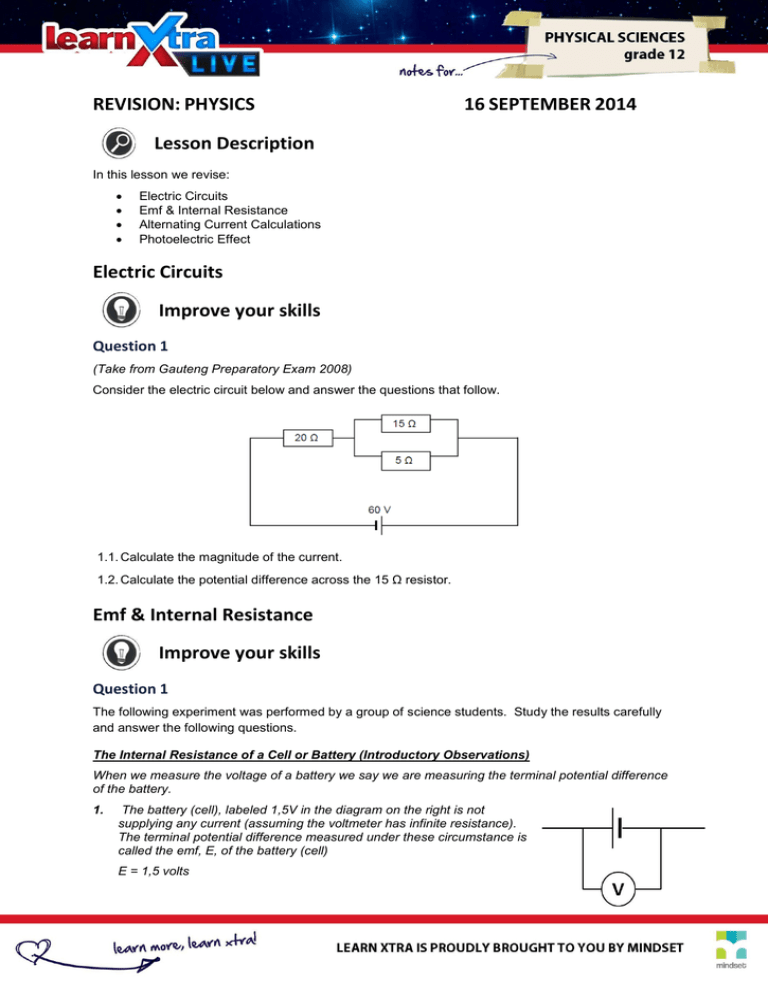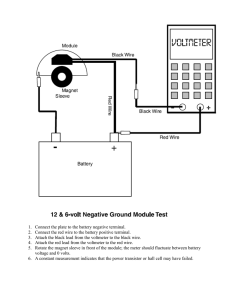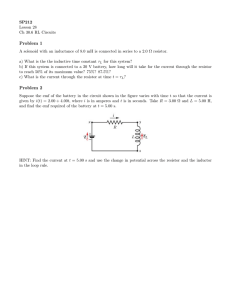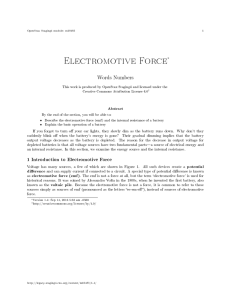LXL_Gr12PhysicalSciences_10_Work and
advertisement

REVISION: PHYSICS 16 SEPTEMBER 2014 Lesson Description In this lesson we revise: Electric Circuits Emf & Internal Resistance Alternating Current Calculations Photoelectric Effect Electric Circuits Improve your skills Question 1 (Take from Gauteng Preparatory Exam 2008) Consider the electric circuit below and answer the questions that follow. 1.1. Calculate the magnitude of the current. 1.2. Calculate the potential difference across the 15 Ω resistor. Emf & Internal Resistance Improve your skills Question 1 The following experiment was performed by a group of science students. Study the results carefully and answer the following questions. The Internal Resistance of a Cell or Battery (Introductory Observations) When we measure the voltage of a battery we say we are measuring the terminal potential difference of the battery. 1. The battery (cell), labeled 1,5V in the diagram on the right is not supplying any current (assuming the voltmeter has infinite resistance). The terminal potential difference measured under these circumstance is called the emf, E, of the battery (cell) E = 1,5 volts 2. 3. The battery is now connected to a resistor and is supplying a current of 0,2A. The terminal potential difference is now 1,3V The same battery is now supplying a current of 0,4A. The terminal potential difference is now 1,1 V 1.1. When a cell is not supplying current, what is the value of the terminal potential of the battery? What is this value known as? 1.2. What happens to the terminal potential as the current in the circuit increases? 1.3. What is ‘lost voltage’? 1.4. Explain why the cell ‘looses’ voltage. 1.5. Using a formula to calculate lost volts, calculate the internal resistance of the cell in the experiment above. Alternating Current Calculations Improve your skills Question 1 (Taken from DBE Preparatory Exam Paper 1 Exam 2008) The waveform on the following page is a graphical representation of the variation of voltage (V) versus time (t) for an alternating current. 1.1. Explain the advantage of using alternating current at power stations. 1.2. Calculate the average power dissipated by this generator if the rms current produced is 13A. Photoelectric Effect Improve your skills Question 1 (Adapted from DBE Feb – March Paper 1 2009) The work function of three metals is shown in the table below. Metal Work function (Wo) in J -19 Aluminium 6,54 x 10 Zinc 6,89 x 10 Silver 7,56 x 10 -19 -19 1.1. Give a reason why different metals have different work functions. 1.2. Light of wavelength 2,3 x 10 m is shone onto a metal X. The average speed of the emitted 5 -1 electrons is 4,78 x 10 m.s . Identify metal X by performing a relevant calculation. -7





